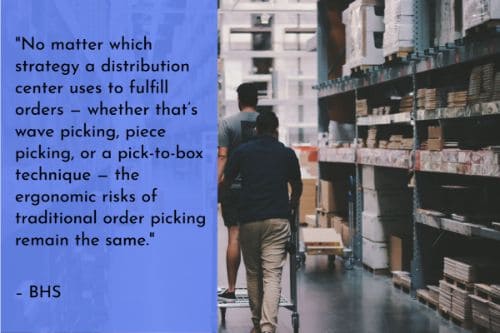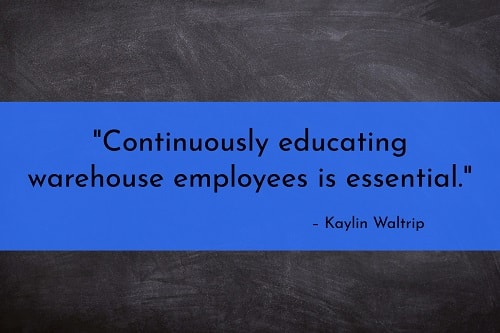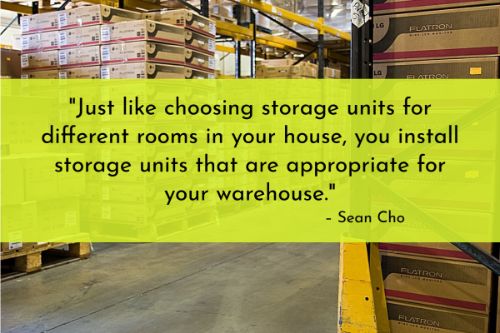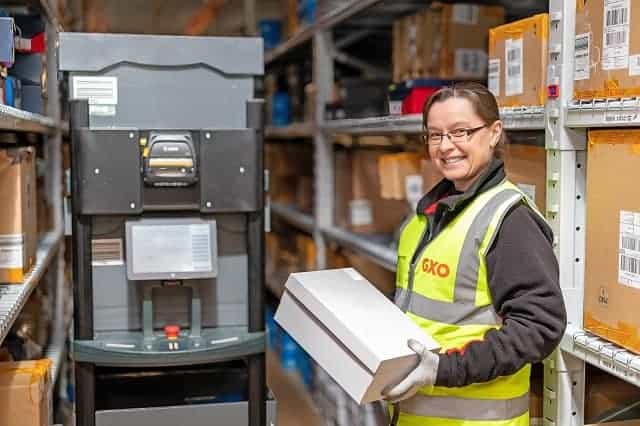The efficiency of order fulfillment from warehouses has become an important focus in logistics management as customers demand quicker deliveries. In a recent survey, 69% of respondents indicated that they would be less likely to shop with a retailer again if they did not receive their delivery within two days of the promised delivery date. Speed is important, but so is the ability to plan accurately and meet commitments. Warehouse order picking is an important factor in efficient order fulfillment.
The modern warehouse is complex, and management must balance a number of factors including software, automation, training and processes such as receiving, picking and inventory management. Warehouse order picking, in particular, has seen significant improvements through technology innovations. In some cases, the typical manual pick rate of 60-80 picks per hour can be multiplied when automation is used. For example, one 3PL doubled its pick rates and improved picking accuracy to 99.9% after implementing 6 River Systems’ collaborative mobile robots. A global home goods retailer implementing Chuck by 6 River Systems realized a 62% increase in pick rates in just three months.
To help you evaluate your current systems and find opportunities for improvement, like how to improve pick rate and organize customer orders, we’ve rounded up 50 expert tips on improving warehouse order picking, from order picking strategies to insightful best practices. Click on a link below to browse order selector and picker tips in a specific section:
- Warehouse order picking tips
- Warehouse order picking strategies
- Warehouse order picking best practices
Warehouse order picking tips

1. Organize with popular items in mind. “Put the popular items nearest. If half of the orders you get come from 10% of the products you have in the inventory, put these items nearest the entrance of the picking area. Sort according to popularity, putting least popular items at the back. This will improve the speed at which orders are picked.” – Shawn Lynch, How to Improve Order Picking Your Warehouse, FlexQube; Twitter: @FlexQube
2. Get to know the importance and functions of picking processes. “Often, the picking process is the most time-consuming process, hence it could become a bottleneck if not done fast enough. The more orders that are picked, the more orders can be shipped, and that means more orders can be invoiced, hence picking directly increases the revenue for the distribution center. Picking also directly impacts the throughput metric, hence improving the productivity and speed of the picking process, which directly improves the throughput of the distribution center. Throughput is the measure of inventory that is received into the inbound dock doors and shipped through the outbound dock doors by fulfilling orders.” – Puga Sankara, 10 Best Practices Today to Improve Order Picking Efficiency in Your Multi-Channel Distribution Centers or Warehouses, Smart Gladiator; Twitter: @sapughazh

3. Take a second look at your most basic organizational tools. “It’s helpful to look at your order picking process as a profile group. An effective order pick supports customer requests and product activity in three categories. The first profile is your order mix. You need to understand your high and low volume mix, and make the best use of material handling equipment. Simple things like proper pallets, containers and bins make an enormous efficiency difference.” – Tips for Improving Warehouse Picking Efficiency, Cherry’s Industrial Equipment; Twitter: @CherrysInd180
4. Focus on improving travel times. “It is well known that travel time makes up the most important factor of the order processing time (it can be up to 50%). This partly depends on factors difficult to change such as building layout, existing racks, and equipment (pallet jacks, carts, etc.) Hence, the objective should be improving travel time through improving picking strategies.” – Abdullah Alkeilani, 8 Ways to Improve Your Order Picking, Longbow Advantage; Twitter: @LongbowAdvantg

5. Increase productivity by focusing on ergonomics. “No matter which strategy a distribution center uses to fulfill orders — whether that’s wave picking, piece picking, or a pick-to-box technique — the ergonomic risks of traditional order picking remain the same. ‘The disadvantages of this system are that Selectors are exposed to a number of musculoskeletal stresses, including heavy lifting, bending, reaching, twisting, etc.,’ reports OSHA.
“Unfortunately, providing ergonomic equipment for order pickers isn’t as simple as installing a Lift Table or providing access to a Bin Tipper. ‘Because employees move about the warehouse, development of mechanical aids to assist with heavy lifting or reducing awkward postures is difficult,’ says OSHA.” – Warehouse Ergonomics: Order Picking and Pallet Building Safety Tips, BHS; Twitter: @BHSbuilt
6. Choose your picking strategies wisely. “With the myriad of advanced alternatives from which to choose, it is imperative that picking strategies be matched with the right technology and software that contribute to solving the DC’s specific challenges. Implementing a solution that is too advanced wastes capital and can often limit efficiency gains, especially during off-peak periods. Similarly, deploying a solution that doesn’t address all of the DC’s specific challenges and requirements can cripple the DC at the busiest times and stunt future growth.” – Picking Methods and Technologies: Making Sense of the Strategy and Technology Options, Forte

7. Ensure that your WMS and ERP are properly synced. Have your inventory manager make sure that the inventory data is synchronized across your warehouse (WMS) and enterprise systems (ERP). The inventory manager must be able to locate inventory with accuracy and ensure that the cycle is done correctly so your inventory count is clearly visible. From an auditing perspective, your on-hand inventory in your DC needs to be accurately reflected in your accounting systems. “Only then can the quarterly financials be accurate and the yearly financials can be accurately released.” – 5 Best Practices in Optimizing the SKU Velocity in Your Warehouse, Load Proof; Twitter: @sapugazh
8. Allocate storage space as inventory levels shift. “If you can determine the amount of space needed for all warehouse processes, it will make good use of the total square footage of the building, and not just floor area. Areas of the building include storage (obviously), shipping, sorting, receiving, packing, employee offices, and product locations. Some other (maybe not so obvious) things to consider are aisle widths, circulation paths, bay heights for shipping trucks, and overhead lighting.” – Avery Walts, Best Practices for Running an Ecommerce Fulfillment Warehouse, Web Retailer; Twitter: @webretailer

9. Increase your operational visibility. “All of this tracking, collection and synchronization data increases the visibility of warehouse operations across all departments. Using a WMS and any additional solution such as Enterprise Resource Planning software can help facilitate access to data.” – Warehouse and Distribution Center Best Practices, Michigan State University; Twitter: @michiganstateu
10. Develop picking routes that enhance your picking strategy. “If order pickers aren’t sure where products are, they may circle back several times leading to time wastage. Establishing picking routes based on the information obtained from the slotting and product velocity analysis helps take the guesswork out and improves accuracy. This can apply to automatic order picking as they have selected the right items in the least amount of time.” – How to Improve Order Picking, LEAN Material Handling; Twitter: @HandlingLean

11. Create extra space in your warehouse. “Are you considering expanding or leasing somewhere? First, ask yourself if it is possible to maximize what you already have. Before you even think about expanding, let alone the high costs this could involve, you must ensure that each storage bin is occupied in a smart and functional way.” – Vincent Paquette, Is Your Warehouse Layout Effective?, Createch; Twitter: @CreatechCa
Warehouse order picking strategies
12. Be mindful of your picking strategies. “In addition to having a great storage plan in your warehouse, it’s also crucial to use the best picking strategy you can. If you have orders that are time sensitive and need to get out of the warehouse fast, it’s important that you have a great picking strategy that can keep up.” – How to Drive More Efficiency with Picking and Packing Best Practices, Need It Now!

13. Guarantee that all inventory is 100% available. “Create an optimized replenishment system to ensure that any given selector will avoid dealing with an empty pick slot that needs to be filled. Also be sure there is no order segregation that cause wait times for missing items prior to shipping. If possible, generate pick lists that show only items that are in stock at any given pick slot. Don’t waste time by having pickers correct inventory data when missing items are discovered.” – Order Picking Strategies for a Warehouse, Warehouse IQ
14. Switch up your storage strategies. “Different storage strategies can boost efficiency within a warehouse. For example, slotting may improve storage intensity, reduce accidents or product damage, reduce congestion and improve retrieval times. Review storage strategies on a regular basis in order to align your practices with seasonal demand.” – Christine Wheeler, 7 Excellent Methods to Improve Picking and Packing Strategies, Newcastle Systems; Twitter: @NewcastleSys

15. Consider batch and cluster order picking. “This function allows workers to scan a batch of cartons once while walking to each distinct location. When a worker picks from one location, they can scan the entire quantity needed for all the cartons at one time, instead of scanning each individual pick. By allowing for batch and cluster order picking, managers can make their workers’ time more efficient and productive.” – How to Improve Order Picking Productivity in Warehouse Management, APS Fulfillment, Inc.; Twitter: @apsfulfillment
16. Reassess your cycle counting processes. “If your warehouses currently practice full inventory counts once or twice a year, switch to a program of cycle counting. This method of regularly counting small inventory groups will save you time and money, as long as you use it in place of, rather than alongside the annual physical count. Not only that, cycle counts enable you to catch discrepancies in a more timely manner, which can reduce leakage and raise inventory accuracy. As a warehousing best practice, cycle counting is one of the most effective ways to improve inventory management.” – 4 Warehouse Best Practices for Stellar Performance, Benchmarking Success, Twitter: @SCBenchmarking

17. Identify the ‘slow kid.’ “It could be that there are a few key flawed components that hold back the entire operation. In one of the more classic examples of product flow, a Scoutmaster noticed that as his troop marched to campsite, the lines got skewed because there was a slow kid in the middle of the pack who couldn’t consistently keep up the pace. His solution? Put the slow kid up front so that all the scouts arrived at the campsite simultaneously and in good order. In your order picking operation, what area is the slow kid that’s causing errors? Is it full or broken cases – or both? How are the pick locations marked? Are order pickers in the right zone at the right time? Are the right products slotted into the right pick locations? Do you execute cycle counts so errors don’t crop up unnoticed? This is a process of elimination that eventually helps you figure out where the problems are – and aren’t. Spend time at every stage – pick face labels, order sheets, pick locations should be checked, and re-checked.” – Scott Stone, 10 Ways to Reduce Inventory Errors Due to Order Picking, Cisco-Eagle; Twitter: @CiscoEagle
18. Get to know split case picking. “Unlike traditional full pallet or case picking, split case picking involves individual products being picked from unique locations and placed directly into shippable cartons. Split case picking is far more complex and labor intensive than its larger scale counterparts. Variable demand has seen a shift from fixed weekly delivery schedules to same-hour, same-day, 24- or 48-hour cycles, with vastly increased picker travel time. With industry estimates suggesting that up to 60% of total pick and pack time is taken up by walking or moving product around and 55% of total costs in a warehouse are from manual labor, this can have a huge impact on your bottom line.” – John Ramsey Mabe, Futureproof Your Warehouse – Six Tips for Split Case Picking, WiseTech Global; Twitter: @WiseTechGlobal

19. Leverage a robust slotting tool to maximize efficiency. “The benefits of proper slotting (the efficient placement of items in a warehouse or DC) might seem obvious—shorter travel times, reduced congestion, better use of space. Yet many companies fail to master the technique and end up paying the price in efficiency.
“Good slotting isn’t easy; in fact, it’s an art, says Saenz. There are a lot of factors or constraints to consider—the SKU’s current and future velocity, its cube, its weight, seasonality, and what else ships with it—and they often contradict one another, he explains. With so many factors to take into account, you can’t just rely on intuition; a robust slotting tool is crucial for piece picking success.” – Susan K. Lacefield, 10 Tips for Improving Piece Picking, DC Velocity; Twitter: @DCVelocity
20. Avoid mixing SKUs. “Mixing SKUs in a single location decreases your picking productivity. Imagine if you had to dig through a location filled with hundreds of blue, green, yellow, orange and pink pens, just to find a red one. Every second wasted searching for the right SKU decreases your warehouse productivity and this can also lead to frustration of your staff.” – Doron Neuhaus, How to Improve Your Warehouse Productivity by Optimizing Your Picking Process, Supply Chain Junction; Twitter: @SCJunction

21. Diversify your strategies as your business grows. “The pick and pack methods that work well for your business will depend on your size and your products. You might change the way you pick, pack, and ship as your business grows.” – Jake Rheude, Ultimate Guide to Pick and Pack Methods, Red Stag Fulfillment; Twitter: @RedStagFulfill
22. For optimized safety and efficiency, opt for automated picking methods. “This type of picking tends to be more productive and efficient, because it eliminates or reduces the need for manual labor. It can also be safer (computer-controlled machines do most of the work) and more accurate (reduces the chance of human error).” – An In-Depth Guide to Understanding and Improving Order Picking, Raymond Carolina Handling; Twitter: @managesmarter

23. Establish a routing strategy that is optimized to your warehouse. “A routing strategy is a strategy by which the route through the warehouse is determined. A route is a path in which you pass all items of an order. If you want to reduce the order picking costs to a minimum, the route has to be as short as possible. There are several routing strategies, but not all of them are suited for any situation.” – Routing Strategies, ERIM; Twitter: @ERIMResearch
Warehouse order picking best practices
24. Establish and emphasize measurement best practices. “Challenge your team with some benchmarks before you start. Ascertain the percentage of SKUs you can now effectively pick with no power equipment. With a little imagination and team collaboration, see if you can’t double that percentage. The long term dividends are an easy payback. With a little teamwork and some simple changes, you’ll be amazed at the productivity gains without breaking the bank.” – Tips for Boosting Picking Speed, Food Logistics; Twitter: @FoodLogistics

25. Not all order picking systems are one-size-fits-all. “Choosing an order picking system depends on a number of requirements, including cost, complexity, the volume of customer orders, and the size of items and orders. Every company has unique requirements, and one order picking solution may suit one business and not another.” – Martin Murray, Order Picking in the Warehouse, The Balance Small Business; Twitter: @thebalance
26. Avoid paper-based picking processes at all costs. “Quite simply: eliminate paper from your warehouse by using warehouse management software with a mobile app. The mobile app replaces the paper, a bit like your mobile phone replaced the handwritten letter. When you remove the room for human error, you’re in a good position to ensure that you’re able to ship every order on time, and accurately, without fail.” – Jonathan Bellwood, 10 Common Problems with Order Picking…and How to Solve Them, Peoplevox; Twitter: @Peoplevox

27. Design your warehouse with efficiency in mind. “Designing your warehouse for efficient picking will dramatically cut down on the time it takes to gather items for orders.
Here are some design principles to keep in mind:
- Place top-selling items nearest the packing stations (since they’re going to be picked more often)
- Store items that are often packed together right next to each other
- Arrange the rest of your inventory from top-selling to least-selling”– How to Optimize the Pick and Pack Process with These 5 Tips, Dear Systems; Twitter: @DearInventory
28. Consider creating a warehouse in a warehouse. “You can gain tremendous efficiency by grouping together the 20 percent of your SKUs that complete 80 percent of your orders. This cuts down on travel time for your pickers. Be sure, however, that the 80/20 area or zone is properly designed to accommodate high-volume activity.” – Deborah Catalano Ruriani, Improving Picking Practices, Inbound Logistics; Twitter: @ILMagazine

29. Kit and assemble items prior to picking. “Always kit or assemble products in advance of the picking. Many times the items are sold individually as well – which can result in kitting too many and then having to disassemble. If you can’t accurately predict the number of kits to assemble, consider the total time to assemble and disassemble. I would always assemble some small quantity in advance, rather than on the fly.” – Michael Manzione, Fulfillment: How to Speed up the Picking Process, PracticalECommerce; Twitter: @PracticalEComm
30. Store inventory at ground level. “Order picking productivity is higher at ground level than when compared to items stored vertically. So if you have the real estate, try and keep as much inventory as possible at ground level. If you run out of room, keep lower-volume items stored vertically, with high-frequency stock kept at ground level.” – Essential Tips for Efficient Stock Picking, Koke Inc.

31. Keep your warehouse neat and tidy. “In addition to optimizing your inventory storage to reduce travel time, you also want to keep things clean and neatly organized for maximum efficiency. Make sure that the supplies your pickers and packers need are neatly organized and easy to access. The floors should be kept clean, and you should remove trash and clutter frequently to avoid accidents. When you receive new inventory, it should be placed in the same area each time for easy picking and packing.” – Dan Scalo, Methods for Improving Your Picking and Packing Process, E-Commerce Nation; Twitter: @ECom_Nation
32. Keep touches to a minimum. “Ideally, when an order is picked and packed, it should only need to be touched once throughout the process. To accomplish this, the order must be error-free and packed correctly the first time, moving directly from shelf to box to truck without having to be moved in and out of totes or repacked into smaller or larger containers. Minimizing this kind of rework helps make the picking and packing process more efficient.” – Monica Orrigo, How to Drive More Efficiency from Your Pick and Pack Process, Handshake; Twitter: @handshake

33. Don’t get stuck on one picking strategy. “Changes are also happening in how people move and work within the warehouse, especially the pick and pack methods. Warehouse picking practices that fill orders, get them packed, and moved out the door are growing and changing as products and order volumes increase too. Start small, and when bottlenecks start to occur, look for new methods and opportunities.” – Adam Robinson, What is the Right Pick and Pack Methods For Your Warehouse?, Cerasis; Twitter: @Cerasis
34. Align all storage strategies with seasonal demand. “Different storage strategies can boost efficiency within a warehouse. For example, slotting may improve storage intensity, reduce accidents or product damage, reduce congestion and improve retrieval times. Review storage strategies on a regular basis in order to align your practices with seasonal demand.” – Prakaash Gunasengaran, DLM, Techniques to Improve the Warehouse Order Picking Process, SIPMM; Twitter: @SIPMM_SG

35. Track your inventory and make those numbers known. “Do not get the order picker confused due to discrepancies between the amount of items recorded on your inventory system and the amount of items you actually have. When the picker finds a difference, they will need to make inventory adjustments and this will take a lot of time. To avoid that scenario, you need to ensure that you can always keep track of your inventory on hand. Therefore, it’s important for you to have a good inventory management system.” – Kanya, How to Improve Order Picking Productivity in Your Warehouse, BusinessTech | HashMicro; Twitter: @HashMicro
36. Create a culture of learning in the warehouse. “Workers of a feather tend to flock together. By integrating experienced workers among seasonal and temporary workers, you create opportunities for team members to learn from peers and grow internal knowledge of warehouse processes. Keen warehouse experience is invaluable – encourage teams to share it.” – The Perfect 3PL Warehouse Pick and Pack Checklist, 3PL Central; Twitter: @3PLCentral

37. Shore up your training techniques. “Continuously educating warehouse employees is essential. From new items coming in to unit of measure changes, additional training provides added clarity, understanding and helps streamline efficiencies.” – Kaylin Waltrip, Increasing Warehouse Order Picking Productivity, Concordance Healthcare Solutions; Twitter: @ConcordanceHS
38. Organize with safety in mind. “What is needed to store a product safely varies depending on the item. Bagged produce has different requirements than dairy, and pharmaceuticals have different requirements than paper goods. Temperature control may be a factor for many types of products, but the required temperature for safe storage will not be the same for every temperature-sensitive product. Depending on the sensitivity of the products to external conditions, other safety factors might be cleanliness or moisture, which will change the product’s optimal slotting location.” – How to Use Warehouse Picking Best Practices, iGPS; Twitter: @iGPS

39. Ensure that proper equipment is provided to all warehouse workers. “Order pickers often need to access vertical shelving and storage space. Make sure their ladders and work platforms are fully enclosed in a handrail and that they wear fall protection when necessary.” – The Explosions of SKUs: Order Picking Challenges and Solutions, Papé Material Handling; Twitter: @PapeGroup
40. Make sure that your picking strategy reflects your warehouse’s design and needs. “For larger distribution centers, voice picking, pick-to-light (and put-to-light), picking modules and robotics automation may give a return on investment for many applications. But, they must be designed to your facility, products and material handling.” – Brian Barry, Selecting the Best Picking Method for Your E-Commerce Business, F. Curtis Barry & Company; Twitter: @FCurtisBarryCo

41. Develop a documentation system you can trust. “The first step toward a productive order picking process is making sure that the picking-and-packing process is well documented and followed by way of clear SOPs (Standard Operating Procedures). Review and fine-tune the process periodically to further improve by eliminating inconsistencies. SOPs should ensure sufficient verification for each step in the process.” – How to Improve Order Picking Efficiency, Silver Lining Storage Solutions; Twitter: @SLStoragetweets
42. Establish a ‘golden picking zone’. “Positioning items in the ‘golden picking zone’ between knees and shoulder reduces effort and increases speed. Store family items, kits and products typically sold together in close physical proximity to facilitate quicker ecommerce fulfillment.” – Craig Stanzel, How to Master Order Picking and Boost Productivity Accuracy, Abel Womack; Twitter: @abelwomack

43. Determine the best locations for your products. “For optimal product flow and velocity through the warehouse, shippers can slot product based on variation in customer demand. For example, an ‘A class’ product that is fast moving and stable should be placed near the front of the warehouse for quick and easy access. Whereas, a ‘D class’ product that’s slow moving and unstable should be placed in back locations.” – How to Create a More Efficient Warehouse Picking Operation, Integral Strategic Solutions
44. Don’t skimp on technology. “Larger operations that handle high daily order volume may need to invest in specialized warehouse fulfillment equipment to make the most out of a batch workflow. Things like slotted picking carts, bin lights, and zone-to-zone conveyor systems can further reduce the time and effort spent per order.” – Josh Barnett, #1 Picking and Packing Mistake Small Businesses Are Making, Shippo; Twitter: @goshippo

45. Understand typical warehouse hazards. “Warehouse safety depends on ergonomics, but different fulfillment tasks carry different ergonomic risks. Order pickers face more than a few of the ergonomic hazards listed by the National Institute for Occupational Safety and Health. These include:
- Lifting, carrying, or otherwise handling heavy loads unassisted.
- Bending or twisting while accessing loads.
- Repetitive gestures, such as reaching, lifting, or carrying loads.” – Jennifer Taylor, Warehouse Safety Guidelines for Order Pickers, Solus Group; Twitter: @SolusGroupInc
46. Set up hot zones to streamline picking. “Order picking efficiency can also be improved through what is termed ‘hit density.’ For example, if a single order picker picks from one out of every hundred locations, then this will be considerably slower than if he / she picks from one out of every ten. Effectively, a higher pick density will equate to higher pick productivity. As a result, it can be wise to set up ‘hot zones’ in your warehouse (similar to the warehouse in a warehouse principle) to concentrate the faster moving lines and speed up picking. Many even give their inventory a label identifying their velocity (i.e., how fast they turnover), allowing strategic organization of products to reduce picking times still further.” – Ian Cook, Advanced Tactics to Improve Order Picking and Packing, GWP Group; Twitter: @GWPGroup

47. Implement a shelving system that fits your warehouse and processes. “Just like choosing storage units for different rooms in your house, you install storage units that are appropriate for your warehouse. The nature of your business will determine the type, size and location of your storage racks, bins and shelves. Make the warehouse space work for you and not the other way around.” – Sean Cho, 8 Ideas for Warehouse Organization You Can Implement Now, Emerge; Twitter: @emergeapp
48. Purchase dynamic equipment. “By purchasing equipment that can be used in a variety of areas with a variety of processes, the cost of doing business will be reduced.” – Tips for Increasing Warehouse Productivity, Manufacturing.net; Twitter: @MnetNews

49. Keep all aisles clear. “Few things hamper productivity in a warehouse more than having to navigate around loose boxes or pallets in the aisles. The time spent keeping your walkways clear will pay dividends by allowing your team to quickly and safely navigate through your warehouse. Preventing clutter from building up also ensures that inventory makes it to the correct location, rather than being placed somewhere else due to a lack of access.” – 5 Warehouse Organization Tips for Ecommerce Retailers, SkuLabs; Twitter: @skulabs
50. Utilize a warehouse management system (WMS) that fits your needs. “The most efficient picking and packing operation won’t matter unless it is part of a well-integrated warehouse operation. Hence the necessity of a good warehouse management system.” – Three Picking and Packing Best Practices for Improving Order Fulfillment, MicroChannel; Twitter: @microchannel
Many warehouses turn to automation to improve order picking efficiency. Download our white paper, 7 Reasons Why Warehouse Robots Beat Traditional Automation, to learn more about how collaborative mobile robots can help keep your associates on-task and boost productivity. We can also discuss the solution that’s right for you. Contact us today.



